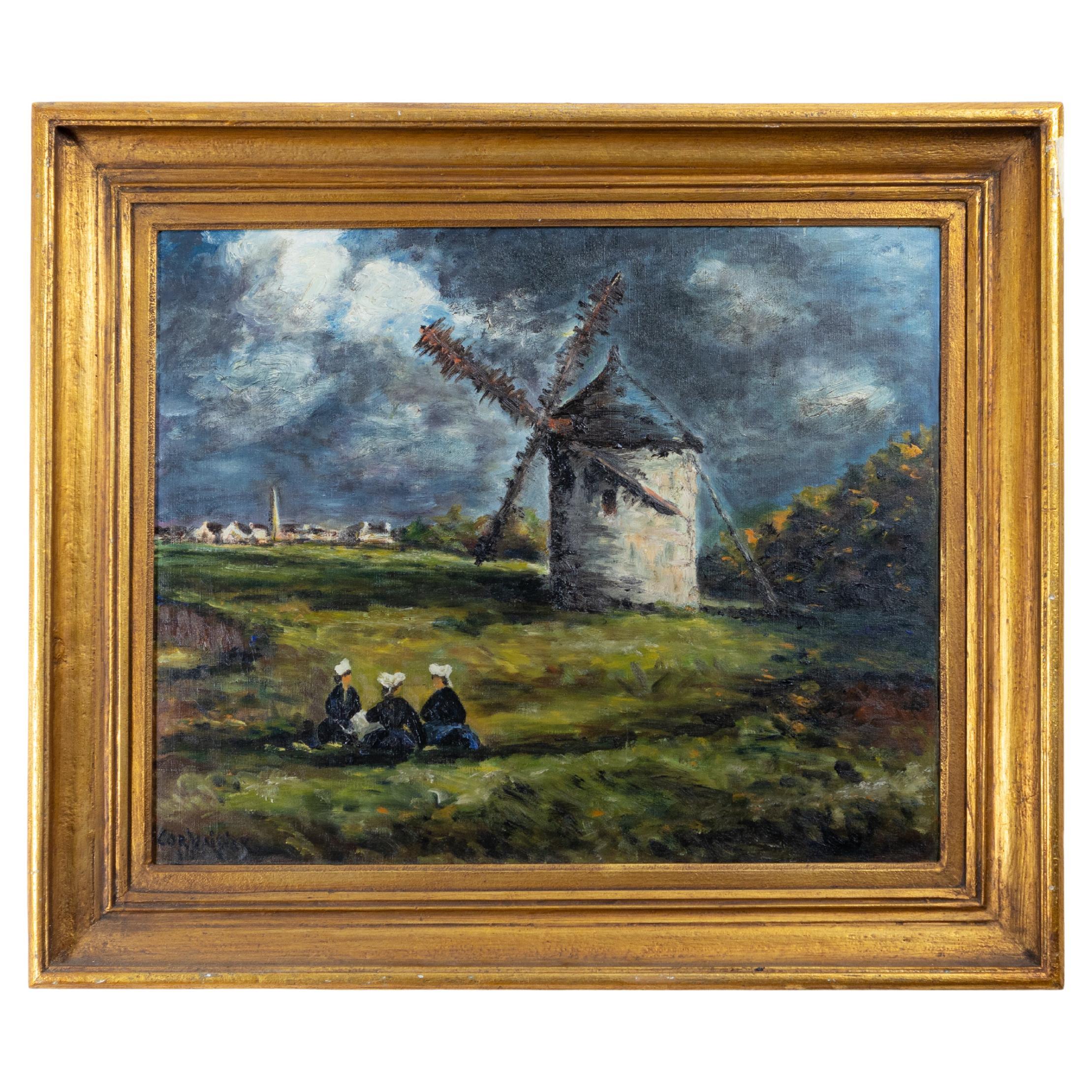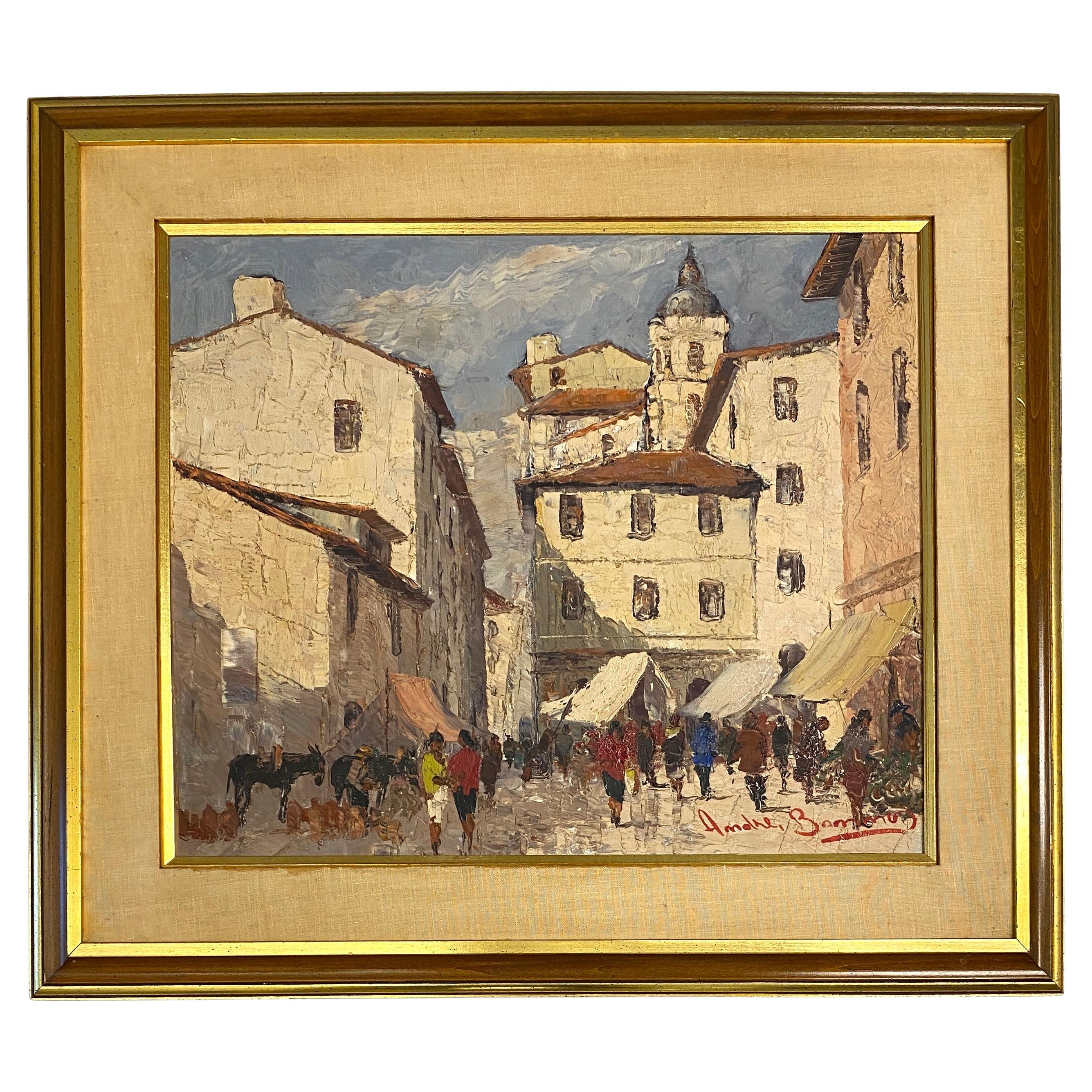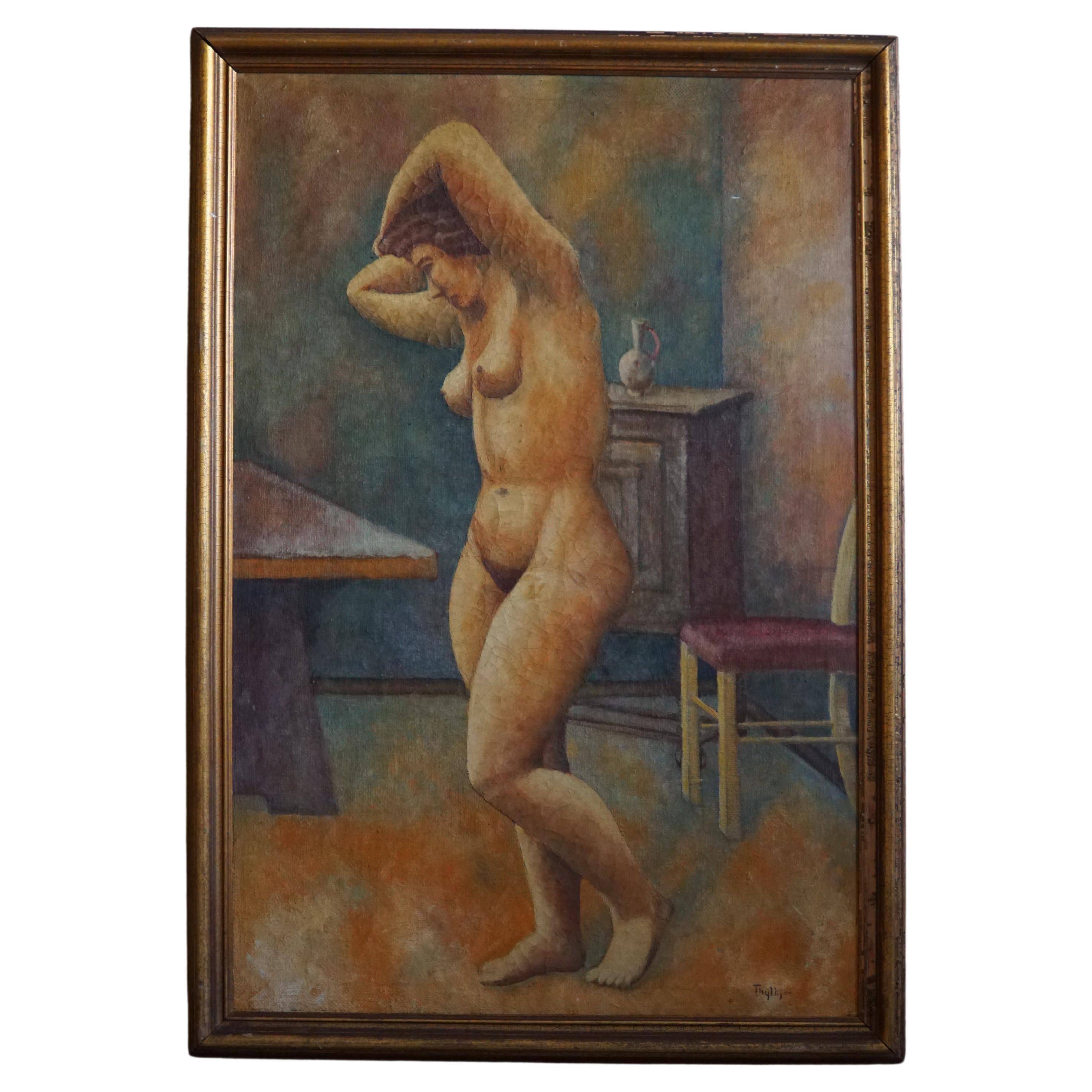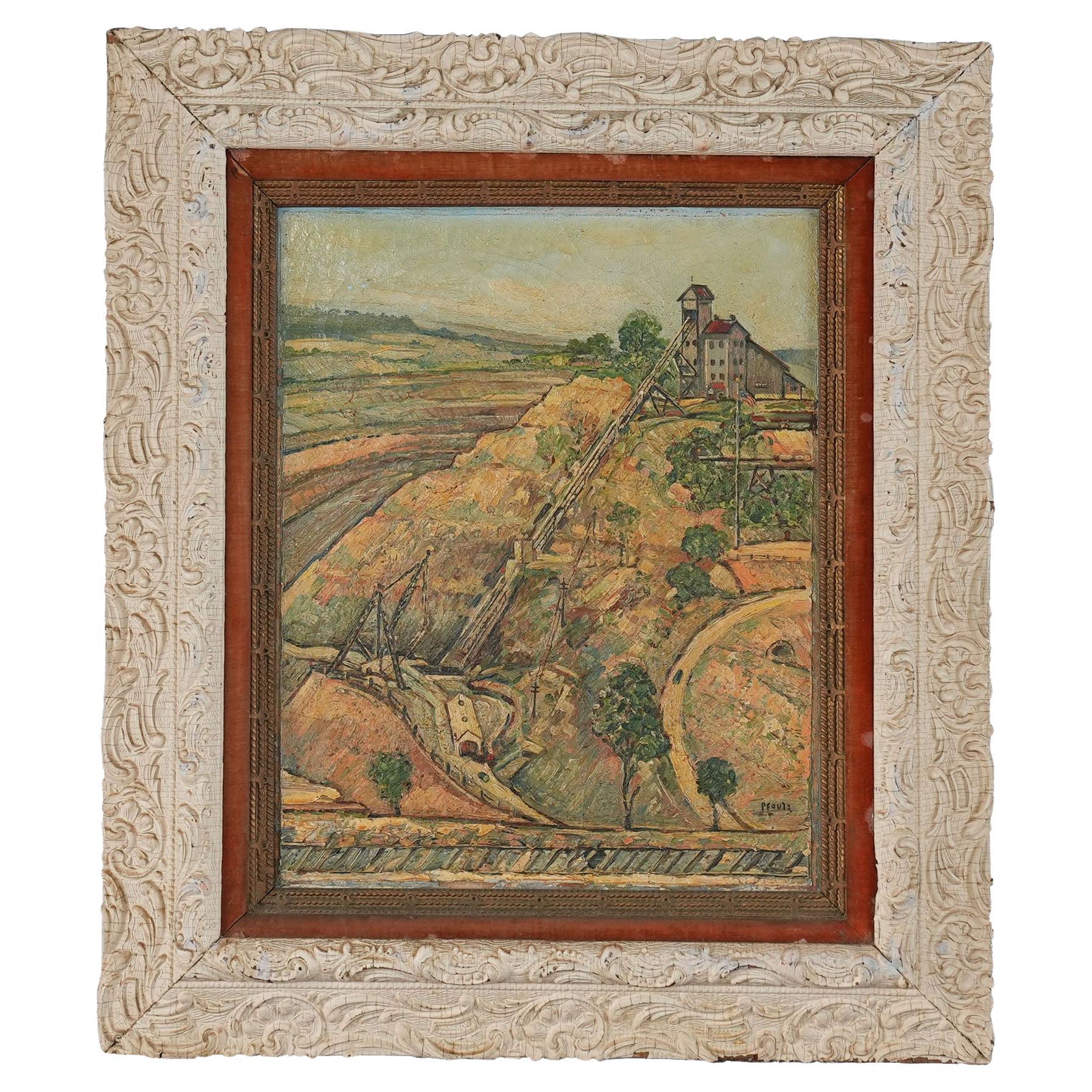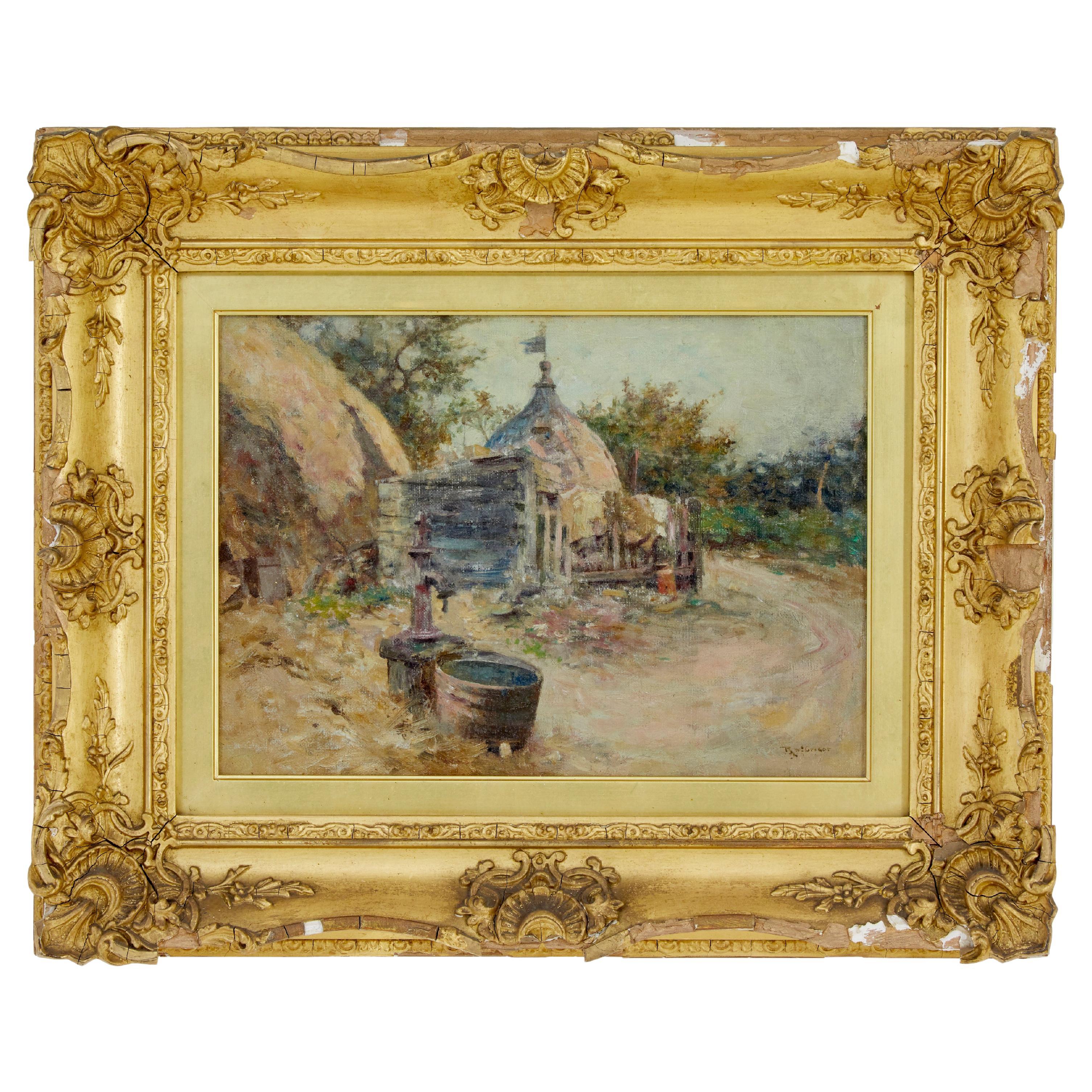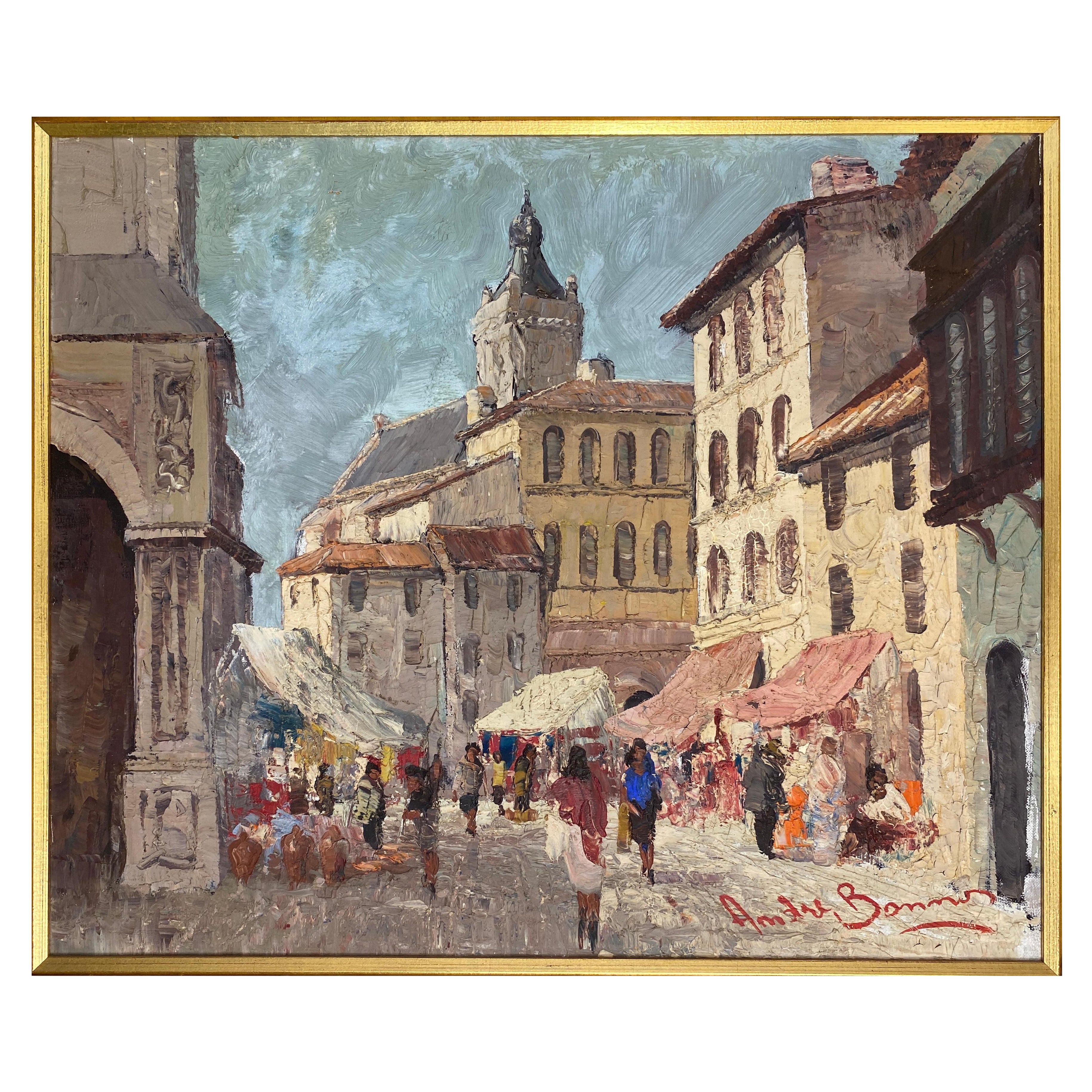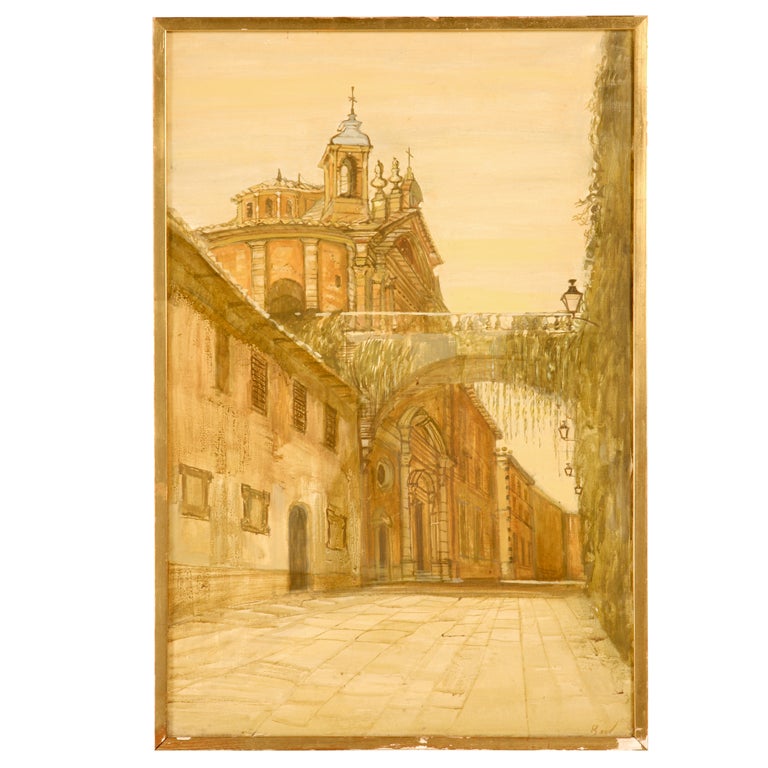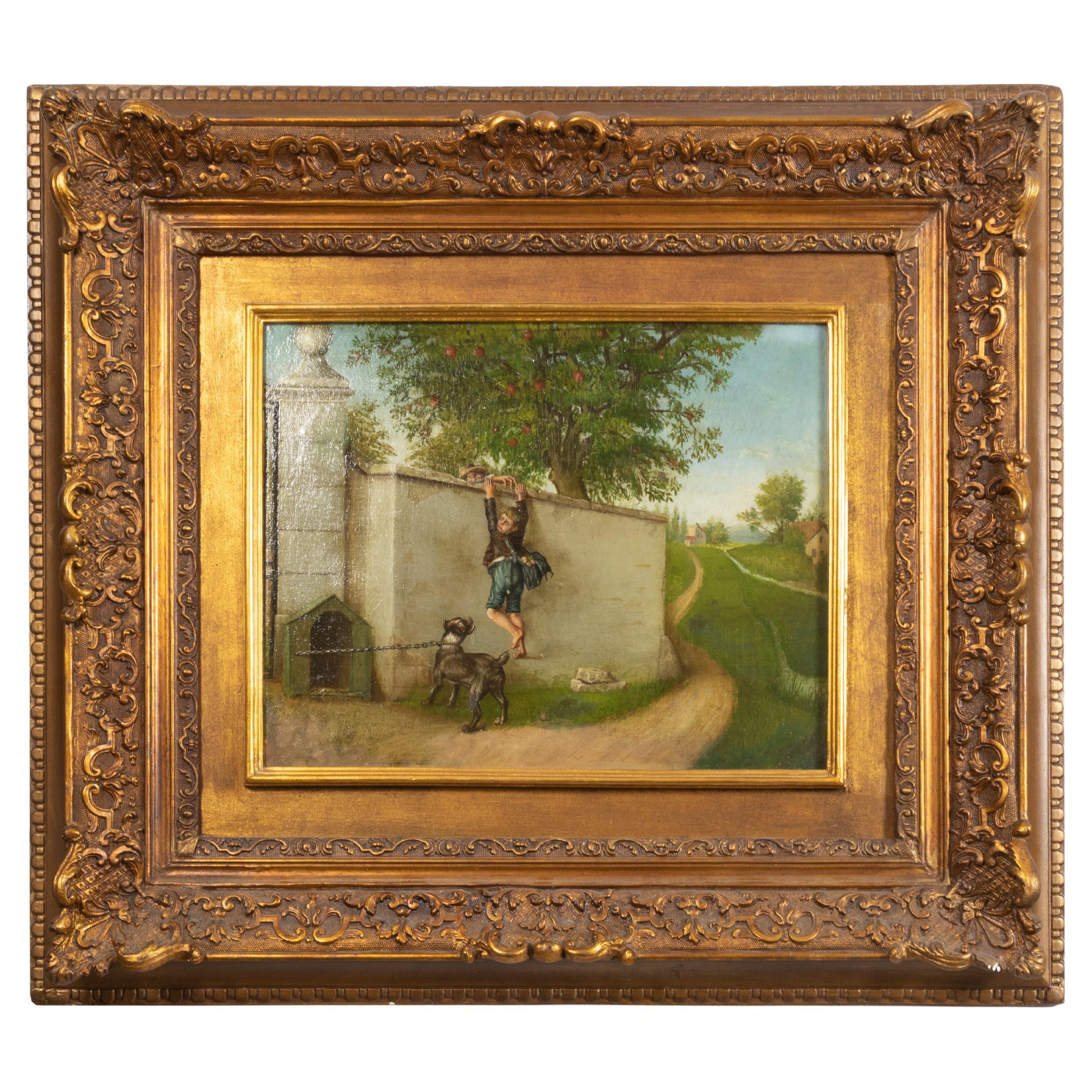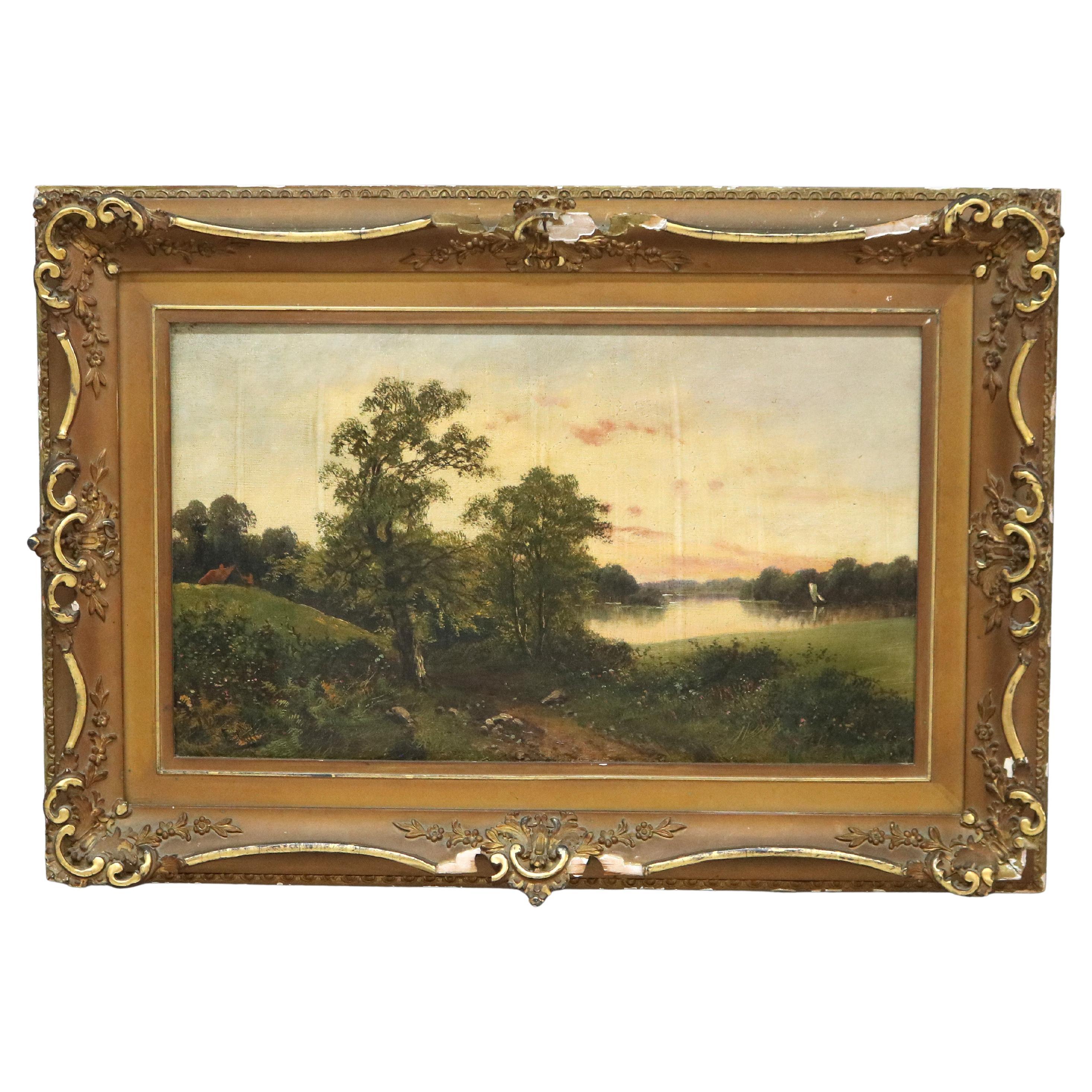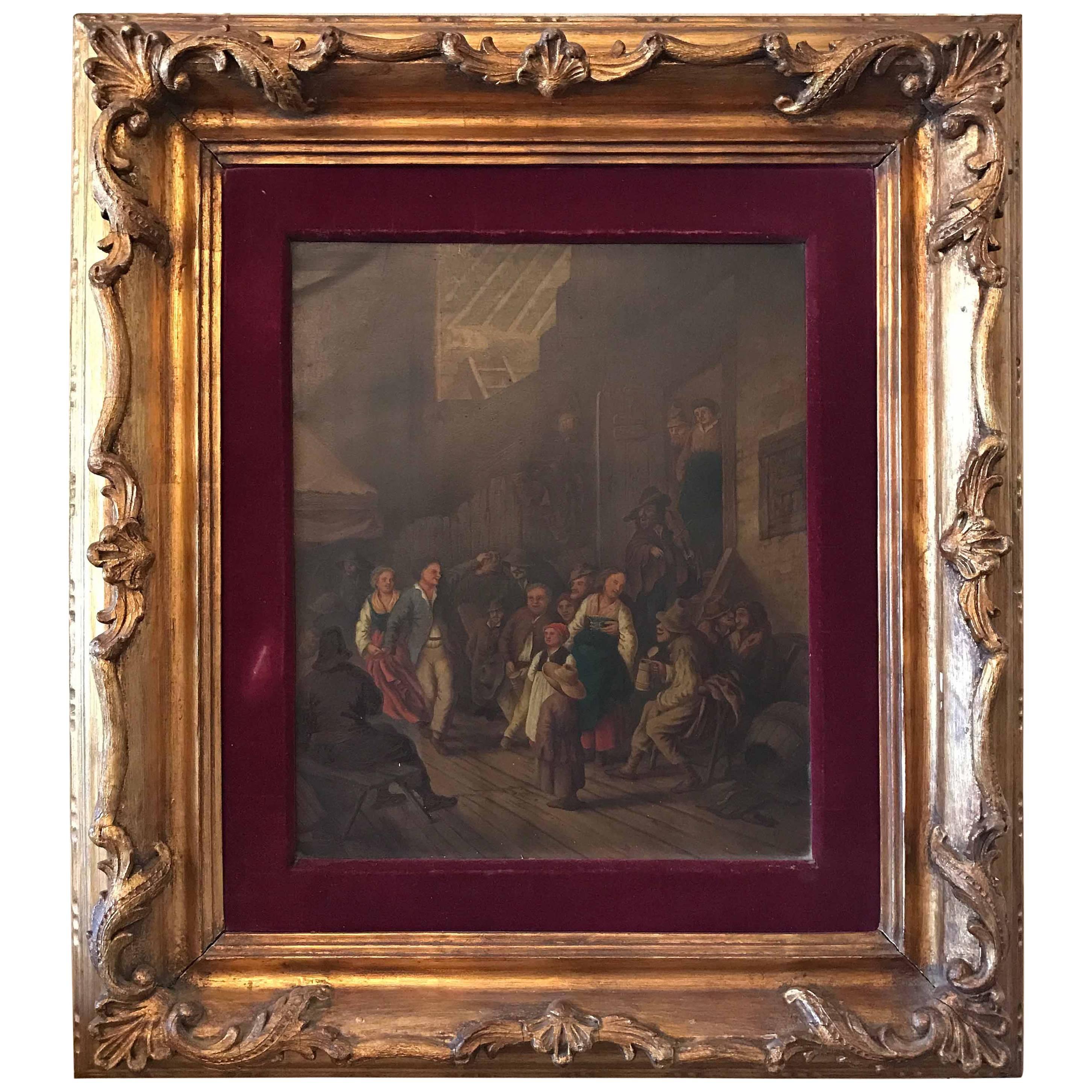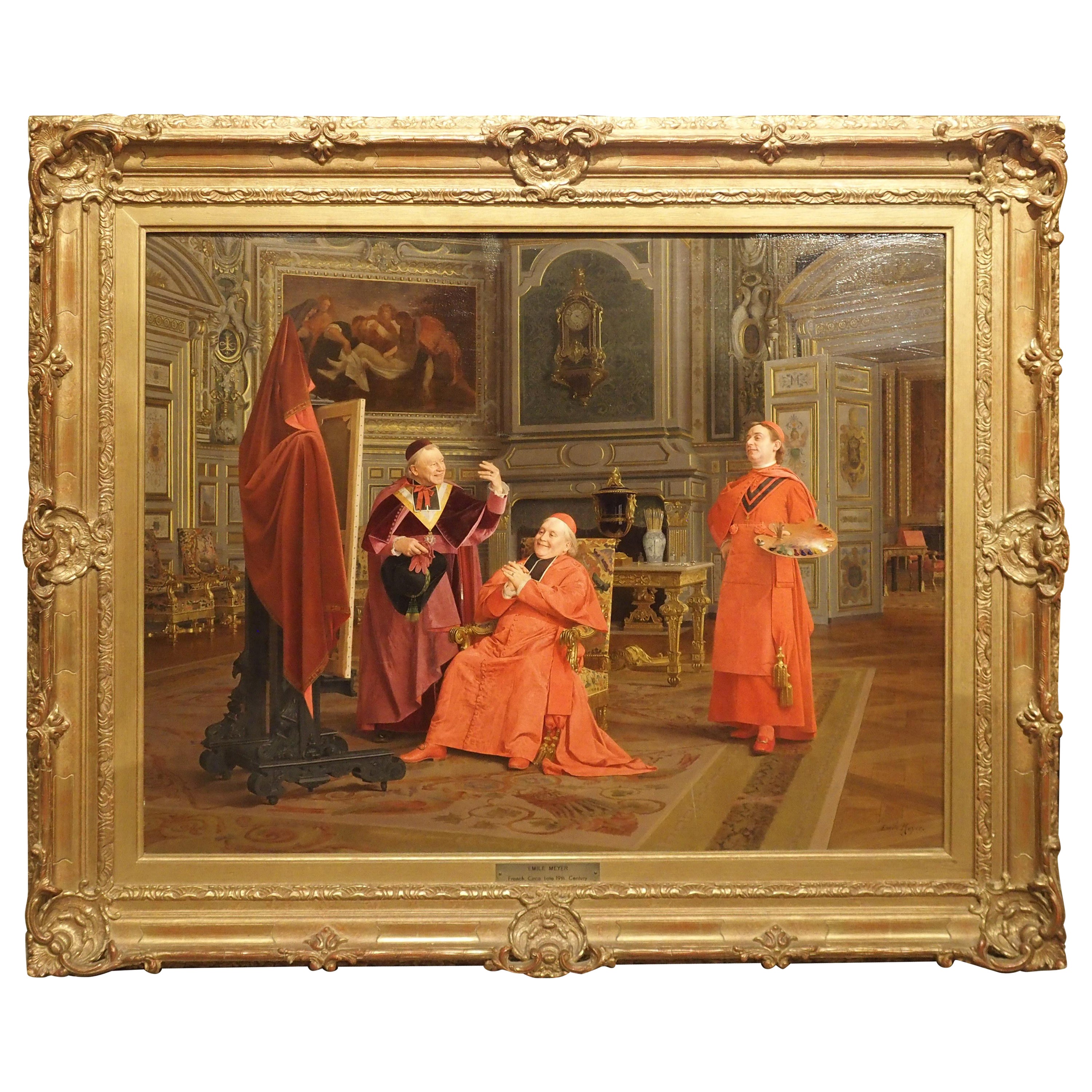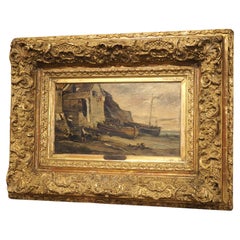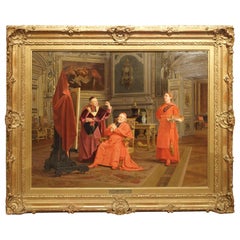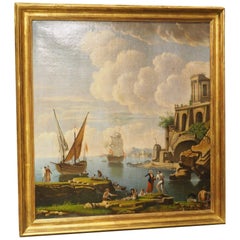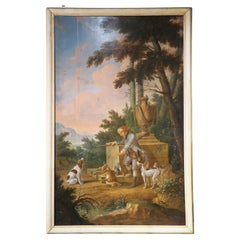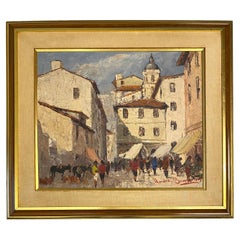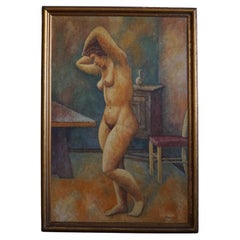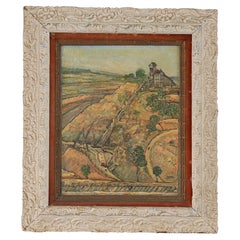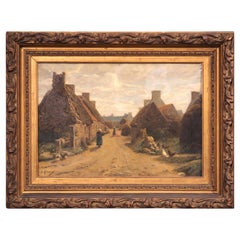
Antique French Oil Painting, A Farm Village Scene by Emile Lienard, Late 1800s
View Similar Items
Want more images or videos?
Request additional images or videos from the seller
1 of 15
Antique French Oil Painting, A Farm Village Scene by Emile Lienard, Late 1800s
About the Item
- Dimensions:Height: 25.5 in (64.77 cm)Width: 32.125 in (81.6 cm)Depth: 3.75 in (9.53 cm)
- Materials and Techniques:
- Place of Origin:
- Period:
- Date of Manufacture:Late 1800s
- Condition:Wear consistent with age and use. Minor losses. Good condition with minor losses and age separations to frame. Some buildup or discoloration to varnish as seen in photos. Light buildup to canvas with a small pinprick. Rigged for hanging purposes. Signed “E. Sienard” in the lower left corner.
- Seller Location:Dallas, TX
- Reference Number:Seller: 423-141B1stDibs: LU906336181312
About the Seller
5.0
Vetted Professional Seller
Every seller passes strict standards for authenticity and reliability
Established in 1983
1stDibs seller since 2011
840 sales on 1stDibs
Authenticity Guarantee
In the unlikely event there’s an issue with an item’s authenticity, contact us within 1 year for a full refund. DetailsMoney-Back Guarantee
If your item is not as described, is damaged in transit, or does not arrive, contact us within 7 days for a full refund. Details24-Hour Cancellation
You have a 24-hour grace period in which to reconsider your purchase, with no questions asked.Vetted Professional Sellers
Our world-class sellers must adhere to strict standards for service and quality, maintaining the integrity of our listings.Price-Match Guarantee
If you find that a seller listed the same item for a lower price elsewhere, we’ll match it.Trusted Global Delivery
Our best-in-class carrier network provides specialized shipping options worldwide, including custom delivery.More From This Seller
View AllFrench Village Harbor Scene, Oil on Board Painting by Eugene Isabey, 1864
By Eugene Isabey
Located in Dallas, TX
Attributed to the renowned French Romantic painter, Eugène Isabey, this seaside painting (dated 1864) effectively uses dark and evocative tones of brown, gray, and beige to depict a ...
Category
Antique Mid-19th Century French Paintings
Materials
Wood, Giltwood, Paint
Antique French Oil Painting on Board, “The Unveiling” by Emile Meyer, 1823-1893
By Emile Meyer
Located in Dallas, TX
During the late 19th century, the French system of government, known as the Third Republic, began to distance itself from the Latin church. As a result, artists at French academies of art began to produce works known as “cardinal paintings”, which were satirical renderings of church dignitaries dressed in vibrant red robes, enjoying their privileged lifestyles. This particular oil on board painting by Emile Meyer...
Category
Antique 19th Century French Paintings
Materials
Canvas, Wood, Giltwood, Paint
18th Century French Port Scene Oil Painting from Provence
Located in Dallas, TX
Sharing similarities of a mid-17th-century Italian capriccio painting, this French oil painting from Provence depicts fantastical architecture set amongst the more realistic setting ...
Category
Antique 18th Century French Paintings
Materials
Canvas, Wood, Giltwood, Paint
Large 18th Century French Oil on Canvas Painting Depicting a Hunt Scene
Located in Dallas, TX
This large (110 inches high) oil on canvas painting depicts a successful hunter, with his felled game displayed near his retriever dogs. Our hunter is leaning against a stone pedestal, clad in blue coat and pants with his rifle beneath his right hand. The man is wearing a gold cap with red fabric attached to it and has a sword on his left hip. Three retriever dogs stand to the hunter’s left, while a fourth sits in front of him (the man appears to be motioning to this dog with his left hand).
An orange terra cotta vase adorned with spiral fluting sits on top of a molded plinth at the top of the pedestal. Ivy has begun to wrap around the vase, which also is festooned with green drapery. On a ledge at the base of the pedestal is the felled game: a rabbit and three birds. The hunting display is surrounded by numerous trees and shrubbery. Mountains and a lake can be seen in the background, beneath a blue sky with pink and orange clouds and birds flying.
Based on the size and vertical orientation, the scene was most likely part of a French boiserie room...
Category
Antique 18th Century French Louis XVI Paintings
Materials
Canvas, Wood
Large 18th Century French Oil on Canvas Painting depicting a Hunt Scene
Located in Dallas, TX
This large (96 3/4 inches high) oil on canvas painting depicts a man and his dog on a hunt in the French countryside. A hunter dressed in red and tan with a mauve overcoat can be seen following behind a white retriever...
Category
Antique 18th Century French Paintings
Materials
Canvas, Wood, Paint
Large Antique French Bronze Sculpture, Bellowing Stag, Doe, and Fawn, Late 1800s
By Clovis Edmond Masson
Located in Dallas, TX
This large French bronze sculpture depicts a family of deer traversing across a rocky terrain dotted with flowers. Sculpted in the late 1800s by Clovis-Edmond Masson, the sculpture has fantastic movement, as all three deer are depicted in full stride, with their hooves off the ground. The largest of the group is a stag with a wide antler spread and detailed musculature. To the stag’s left is a doe looking back towards a fawn, who is looking up at the stag. The sculpture has a rich, green-brown patination with areas that have retained the gold of the bronze. Behind the doe are two engravings: “C. Masson” and “Salon des Beaux-Arts”, indicating that the sculpture is the work of Clovis-Edmond Masson and was exhibited at the Paris Salon (the original).
Clovis-Edmond Masson was born in Paris in 1838 and specialized in sculptures that accurately depicted animal behavior. Masson exhibited at the Salon regularly from 1867-1881, placing this sculpture in that time frame. The most famous work by Masson was commissioned by Rama V...
Category
Antique Late 19th Century French Animal Sculptures
Materials
Metal, Bronze
You May Also Like
Barbizon School Oil Painting, Windmill Scene, France, 1800s
Located in Lisbon, PT
This 19th-century French oil painting, signed “Corvoisier,” is a strong example of the Barbizon School tradition, known for its focus on the natural landscape and rural life.
The co...
Category
Antique 19th Century French Barbizon School Paintings
Materials
Canvas
French Village Scene, Oil on Canvas Painting Village in France
Located in Miami, FL
French Village Scene oil on canvas painting
This charming French oil painting captures the essence of everyday life in a picturesque French village. The vibrant scene features bustl...
Category
Mid-20th Century French Mid-Century Modern Paintings
Materials
Canvas, Wood, Paint
Large Oil on Canvas Painting, Unknown Danish Artist, Late 1800s
Located in Odense, DK
This oil on canvas painting by an unknown Danish artist, made in the late 19th century, is a striking and evocative work of art. The painting depicts a naked woman posing.
The use of...
Category
Antique Late 19th Century Danish Romantic Paintings
Materials
Canvas
Pfoutz Original Farm Scene Oil Painting
Located in Annville, PA
A very interesting and unusual Pfoutz Original Farm Scene Oil Painting by artist J. Earle Pfoutz. The painting is produced on artist and comes complete with what appears to be an original artist decorated/painted frame. The Pfoutz Original Farm Scene Oil Painting is signed on the front by the artist and appears to be dated 1948 on the rear. Known for his unusual subjects Pfoutz outdid himself with this effort, capturing the essence of a Lancaster County farm but with the startling twist of portraying a large turkey vulture in the foreground. Definitely unique.
Overall frame Size approximately 33″ wide x 3″ deep x 26″ high
J. Earle Pfoutz had a long and distinguished career as a self trained artist. More can be learned about him from reading this article produced by Gary Hawbaker at askART
Earle Pfoutz Born: 1891 – Lancaster, Pennsylvania
Died: 1957
Known for: Landscape, figure, still life painting
An image of J Earle Pfoutz
Biography from the Archives of askART
J. Earle Pfoutz (John Earle Pfoutz) – (Oct 23, 1891-Nov 9, 1957)
“A seventh generation descendant of a Swiss family which arrived in America early in the 17th Century, J. Earle Pfoutz was born in Lancaster, PA, son of John Bachman and Susan Allison Pfoutz. He painted houses for a living and pictures for a life.
A self-taught artist, described as a primitive, he was distinctive for his vivid imagination and bold color application. He painted hundreds of Lancaster County scenes. Pfoutz traveled through the hills near his home and along the Susquehanna River in search of scenes. He began painting with a brush when he was fourteen, but added a palette knife after suffering an eye injury. He completed eighth grade in the Lancaster Public Schools and there his formal education ended. However, the Department of Public Instruction of the State of Pennsylvania thought so highly of his work as an artist that officials certified him as an art instructor and he taught for a year in the York (PA) public schools. He also was an art instructor under the program for disabled veterans, sponsored by the Veterans Administration, when he gave private instruction to veterans in their homes.
In 1947, J. Earle Pfoutz finally earned national recognition as an artist. His painting, Opalescent October, was chosen by the Museum of Art of Dayton Ohio, to travel all over the country for a year with its Group Exhibition. Described as a “very colorful, calm scene, iridescent in color, sweeping in design,” the painting started on its journey around the country early in 1948. In an interview with the Sunday News (Lancaster, PA – Nov 2, 1947), Pfoutz stated that he didn’t know whether he was a “primitive” or an “impressionist.” No master taught him, no school channeled his style. “Sometimes I didn’t eat, but I always managed to paint,” he recalled. Many of his hundreds of canvases -most of them not sold, but given away to friends – found their way to other parts of the country. “I never remember the day when I did not love color,” Pfoutz said. “I was about 12 years old when I saw my first palette – a string of different colored paint paddles that graced the stores of that day. As a boy I had two great desires. One was to be able to eat all the strawberry jam I could, and the other to possess a string of those beautiful paint paddles. Well, I’ve got my fill of jelly, but I’ve never yet got my fill of beautiful colors.”
In 1950, Pfoutz’s one man show of paintings made front page headlines in the Lancaster Intelligencer Journal: “Most of the twenty oil paintings on exhibition are landscapes, although there are several interesting figure studies. Colors again, as in all Pfoutziana are rich and full-bodied, but for the most part not as startlingly as in some of the earlier work. Most of the paintings were done during the past year, and also reveal the painter’s characteristic heavy impasto technique, in which the rich swirls of paint carry their own message. Among the figures, The Banjo Picker, and The Magician, are the most provocative. Both are character studies; the first being of a tramp musician whose drab clothing is set-off by a luminous aqua blue background. Modern in feeling and treatment is The Magician, a clown-faced wizard whose spinning ball in the air suggests the fourth dimension – space. The use of the primary colors in this picture serves to emphasize the theme effectively.
A large colorful landscape, Opalescent October, depicting rolling hills against a late afternoon sky is new to Lancastrians, as it has just returned from Dayton, Ohio, where it hung in the Dayton Art Institute. Another landscape with soft dreamy colors is Fantasie D’Autumne, and one of the loveliest pictures in the show. Pennsylvania Dutch Country is another with eye appeal, and was one of the works which was hung in the Old Customs House in Philadelphia during Pennsylvania Week, and before that in a collection of Pfoutz work in the same place. In deep contrast to the sunny skies and brilliant foliage of many of the pictures, is the somewhat morbid Worry, in which the center of interest is a tremendous rat. This, the painter explains, was symbolic of 1948 in China, which was ‘The Year of The Rat’ in the Chinese calendar. Background material for the picture was furnished to Pfoutz by author Pearl Buck.
Other pictures include Autumn Prelude, Miners Village, painted at Cornwall, PA; Humid Day, Saint Peters Kierch, at Middletown, PA; Lady Pfoutz, inspired by the painter’s wife; Sun Flowers, Sentimental Journey, Gyne, Luzon Woman, Old Bridge, The Cow Path. Lemures, based on Roman mythology, and Ethiopian, painted from an ebony wood carving from Kenya Province, S. Africa.”
In 1953, Pfoutz was installed as President of the Lancaster County Art Association. A. Z. Kruse, New York City artist, writer and member of the faculty of the Brooklyn College and the Cartoonists and Illustrators School, Manhattan, was the guest speaker. In January of 1953, thirty-five Pfoutz oils were exhibited at the Old Custom House in Philadelphia, PA under the sponsorship of the Carl Schurz Memorial Foundation. Several Lancaster County landscapes and covered bridges were included as well as Katy, a Pennsylvania Dutch scene. Symbolic paintings included End of the Second Day, the artist’s visualization of the second coming of Christ, and Twilight, typifying the grief of mothers of all lands for sons lost in battle.
In June of 1953, a Pfoutz oil made history in Lancaster. From the Lancaster New Era: “For the first in local art history, a painting has been withdrawn from an exhibition because of objections from viewers and hostesses serving at the show. The painting, Jeune Fille, a standing nude done by Pfoutz, was one of the paintings in the annual spring exhibition of the Art Association and had become the center of the controversy. Pfoutz said he took the painting down… ‘graciously but reluctantly.’ ‘From an artistic standpoint, there is nothing offensive about the painting,’ Pfoutz said. ‘This community just wants its nudes with clothes on.’ “It is most brilliant in color, and because it is so brilliant I thought it would make a nice lively spot for the show. This is the first time I’ve had to take a picture off the walls. I substituted a seascape for it.’ Pfoutz said he felt the painting brought a lot of viewers to the show because it was so controversial. It had never been exhibited before. ‘If this had been shown in a metropolitan city,’ he commented, ‘people wouldn’t have given it a second glance. But the viewpoint here is more conservative, even though I don’t think moderns would have minded.’ He said he felt the painting was neither ‘objectionable nor pornographic,’ but had complied with the wishes of fellow members of the Art Association who telephoned him to relay the protests they had received. The art controversy was the first to arise here publicly since the showing of Amish Grandmother, an oil by William Gropper which was part of the Gimbel Pennsylvania exhibit at the Griest Building several years ago. — Numerous viewers of Amish Grandmother, [a painting showing an Amish woman holding a white goose], expressed themselves quite vocally, calling it an affront to the Plain Folk. But it stayed on exhibit throughout the length of the Gimbel show. Pfoutz expressed no rancor, implying that if Gropper could take it so could he.”
After his death, there were several shows of Pfoutz’ work organized by his son J. Earle, Jr. J. Earle, Jr. also saw to it that President Eisenhower would receive an oil called The Cow’s Path. The president first saw the painting in 1950 when, as president of Columbia University, he visited Lancaster to address a student assembly at Franklin and Marshall College. After his address was over, the then Gen. Eisenhower stopped at the Fackenthal Library on the campus to view an exhibition of Pfoutz’s paintings. The Cow’s Path intrigued him. For some time, as his aides fumed to get him back on his time schedule, Eisenhower and Pfoutz talked, as artist to artist. Prior to his death, Pfoutz requested that The Cow’s Path be given to the President if he wanted it. The painting was presented to Ike at the White House in November of 1959. Mrs. Eisenhower owned a Pfoutz painting titled, In the Manor.
Though house painting was his livelihood, he worked for Millersville State Teachers College (now a university) for a time during World War II, and called himself “the Chimney Sweep of MSTC.” During that period he knocked out a dizzying canvas in the surrealist style (he thought it was terrible) and got into the campus newspaper when one of the students spotted it.
Earle Pfoutz was not the humble, downtrodden artist, not the Douanier Rousseau type at all. As he developed his skill and style through the years, he also fashioned a resilient confidence in himself as an artist. Whether he was building his own home (he built two) or painting one for somebody else, he never lost faith in his ultimate recognition—though he was never sure he would live to see it.
Whether he was working as a rigger for a hoisting company, in the Stehli Silk Mill of Lancaster, carving Cloister-style chairs, decorating old chests, cementing bricks from the old Safe...
Category
Vintage 1940s American Paintings
Materials
Paint
Robert Mcgregor genre oil painting of french village scene
Located in Debenham, Suffolk
Robert Mcgregor genre oil painting of french village scene circa 1890.
Here we have a robert mcgregor (1848-1922) painting illustrating peasant life. This is a well-balanced oil on ...
Category
Antique Late 19th Century English Victorian Paintings
Materials
Canvas, Giltwood, Paint
French Village Street Scene Oil on Canvas Painting, Busy Street in France
Located in Miami, FL
French Village Scene oil on canvas painting
This charming French oil painting captures the essence of everyday life in a picturesque French village. The vibrant scene features bustl...
Category
Mid-20th Century French Mid-Century Modern Paintings
Materials
Canvas, Wood, Paint
